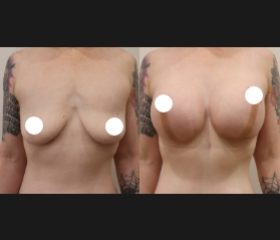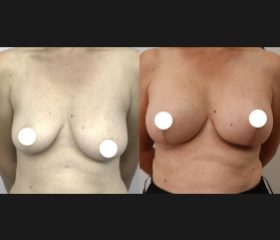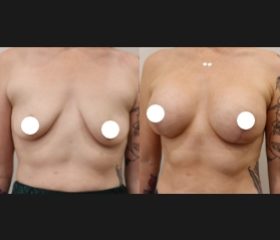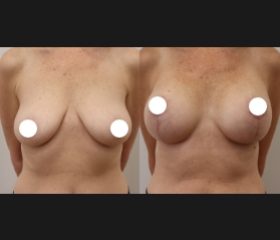A procedure to increase the size, and improve the shape of a breast.
Breast Augmentation (augmentation mammoplasty) Brisbane
Generally, breast augmentation (augmentation mammoplasty) surgery is conducted purely for aesthetic reasons. However, breast augmentation (augmentation mammoplasty) surgery has many functional benefits too, including the correction of deformities. It’s also a reconstructive option for women who have experienced breast cancer and undergone a mastectomy. Not everyone is a suitable candidate for breast augmentation (augmentation mammoplasty) surgery. Dr Perron highly recommends extensively researching the procedure prior to making the decision to undergo surgery. During your initial consultation, Dr Perron will also discuss your specific circumstances and expectations and help decide what is best for you.
Breast augmentation (augmentation mammoplasty) improves the appearance of the breasts. This surgery may be chosen for both aesthetic and functional purposes.
Check out this video of Dr Justin Perron discussing the topic of choosing the right implant for your augmentation.
The goal of breast augmentation (augmentation mammoplasty) is to enhance the size and shape of the breasts. Prior to your surgery, Dr Perron will help you make a decision regarding the type of implant you would prefer. Decisions on the shape, texture, size and projection of the implants will also need to be made. You will also need to decide on the type of incision you would prefer and whether you would like to place the implant over or under the muscles of the chest – Dr Perron will take you through the pros and cons of all your options.
A breast augmentation (augmentation mammoplasty) operation takes approximately 60-90 minutes, and is performed under a general anaestheticn in one of our Registered Hospital Facilities.
Breast implants can be placed using one of three types of incisions:
Each of these approaches has its own benefits and drawbacks. The reason for choosing one approach over another can be due to surgeon preference, type of implant, as well as patient preference. The most common approach is infra-mammary (in the breast crease), which is also Dr Perron’s preferred approach. The infra-mammary incision is popular because it provides your surgeon with the most unobstructed view and any scarring can easily be hidden underneath swimwear or underwear. It’s also one of the most flexible type of incisions, meaning that it meets the requirements of most patients.
The location or placement of an implant is most commonly behind the chest muscle (pectoralis major, or ‘pec’ muscle). Typically, part of the implant is placed behind the muscle, and part behind the breast tissue (dual plane). There are variations to this technique and they are used in various ways. The technique used depends on a patient’s individual anatomy and the type and size of the implant.
Once Dr Perron has inserted and positioned your chosen breast implants, he will close your incisions with sutures layered in the breast tissue. You will most likely return home on the same day as your breast augmentation (augmentation mammoplasty) procedure.
Recovery times can vary, but it usually takes about one to two weeks before you feel more like yourself again. Returning to full physical activity (gym work/heavy lifting) should be avoided for two to three months, depending on the type of implant. Breast swelling can persist for several months before a final result is seen.
Although uncommon, like all surgical procedures, complications can potentially occur. This will result in a longer recovery time. However, most patients recover effectively during the first two weeks. After these two weeks, you will generally be able to return to social activities and office-based work. By this point, swelling will largely be resolved, and you may start to feel more comfortable with your new figure. You should limit more strenuous physical activity for six weeks.
Dr Perron offers breast implants in a vast range of sizes so that you can customise your implants to your desired surgical result. The size of breast implants is measured in a metric unit of volume known as a ‘CC’. Usually, breast implant sizes range between 125cc and 700cc.
Keep in mind that a certain sized implant does not guarantee a particular bra cup size. In fact, two women with the same implant can achieve very different results, depending on their weight and frame, the size and shape of their ribcage and the volume of their existing breast tissue. Dr Perron will work with you to determine which size implant will best achieve your desired results.
Traditionally, there are two types of breast implants to choose from: saline and silicone. While both achieve a similar look, there are pros and cons to each.
Saline implants have an outer shell made of silicone and are inserted into the breast empty. Once inserted, they are filled with sterile salt water. However, saline implants are not commonly used in Australia, as they can be seen more easily under the skin and may ripple or leak.
Silicone implants are the preferred choice in Dr Perron’s practice, as they look and feel more natural. While they will not leak like their saline counterpart, silicone implants do have their own set of associated risks, which Dr Perron will discuss with you during a consultation.
Breast implants are available in two different shapes: round and anatomical (teardrop). The right shape for you will depend on various factors, including but not limited to your natural body shape, the amount of existing breast tissue and the level of breast sagging.
Round breast implants are ideal for patients seeking a more augmented look, with lots of fullness in the upper breast. As the implants are perfectly round, they will emphasise the natural shape you already have, making them an excellent choice for patients with great natural shape, minimal breast sagging and central nipple placement.
Anatomical implants are teardrop-like in shape, with more fullness in the lower half of the implant. Teardrop implants mimic the natural shape of the breast and are most suitable for patients with minimal breast tissue, mild sagging and concerns regarding shape (i.e. tuberous breasts).
The outer shell of your breast implants may have either a smooth or textured surface, depending on your preference. Smooth implants feel softer and look more natural than textured implants, however, they may potentially slide out of position. Textured implants, on the other hand, have a rough outer shell, which creates a firmer feel. All teardrop-shaped implants are textured in surface to prevent rotation of the implant. Textured implants are also associated with a lower risk of capsular contracture.
Implant profile refers to how far the implant projects forward from the chest wall. Breast implants are available in a large range of profiles, although the most common are low, moderate and high.
Low profile implants are mostly flat in appearance, meaning they only give a minimal amount of projection. Moderate profile implants give a more moderate amount of projection and provide the most natural-looking results. High profile implants provide maximum projection, meaning that they give the most full, rounded results.
There are risks with any type of cosmetic surgery procedure. The general risks include the following:
Specific risks associated with breast augmentation (augmentation mammoplasty) include the following:
In our Brisbane clinic, Dr Perron will take you through all of the potential risks during your consultation and explain how you can reduce the likelihood of these complications occurring. Unfortunately, not all complications can be avoided, capsular contracture being one of them. In the event that an implant ruptures or the breast hardens, a second procedure will be required. During this, patients can either choose to replace the implant or remove both implants completely.
Please be advised that all procedures carry risks, therefore, we encourage patients to consult with their regular GP and Qualified Specialist Plastic Surgeon before considering surgery. Find more information here.
The cost of breast augmentation (augmentation mammoplasty) can vary widely between patients. On average, you can expect a Breast Augmentation to cost anywhere between $7,000 and $15,000. Breast augmentation can be a complex procedure to price due to the multi-faceted cost structure typically involved, along with each patient’s procedure being tailored to their needs. To receive the most accurate breast augmentation quote, we recommend discussing your individual surgical plan with Dr Perron during a consultation.
The price of your breast implant surgery can be divided into four main cost components: surgeon’s fees, anaesthetist’s fees, hospital fees, Garment fee’s and implant costs.
First of all, Dr Perron will charge a fee to perform your breast augmentation (augmentation mammoplasty) procedure. Surgeon’s fees can fluctuate vastly from surgeon to surgeon, depending on factors such as their professional qualifications, experience and recognition. The fee Dr Perron charges you can vary, depending on the complexity of your procedure.
Dr Perron performs all breast augmentation (augmentation mammoplasty) procedures under a general anaesthetic and works with the most qualified anaesthetists to ensure your safety and comfort during surgery. You will be given an estimation of your anaesthetist fees prior to your breast augmentation (augmentation mammoplasty).
You will also need to pay a fee for the use of hospital facilities. Dr Perron performs his surgeries at the Spring Hill Sepcialist Day Hospital, Brisbane Private Hospital, St Andrews War Memorial Hospital and The Wesley Hospital. As breast augmentation (augmentation mammoplasty) is usually performed as a day procedure, your hospital fees will only include the time spent in the operating theatre and the time it takes to recover from anaesthesia. If an overnight stay is required, you will need to pay additional fees, which will be quoted prior to surgery.
Finally, you will need to pay for your breast implants. Implant costs can vary significantly, depending on the brand, size, shape and texture you choose. For instance, anatomical implants are usually more expensive than round implants. Bigger sized implants will also cost more than smaller breast implants.
As a cosmetic procedure, breast augmentation (augmentation mammoplasty) won’t be covered by private health insurance or Medicare. However, if you are seeking breast implants for a medical reason, such as after a mastectomy, you may be able to receive some reimbursement – this will be determined at your consultation with Dr Justin Perron.
Figures listed are Surgeons fees only. Other fees might include: Anaesthetic fees, Hospital fees, Garment fees, Implant/ Prosthesis fee’s, Assist fee’s. All patients are different and require different treatment approaches, therefore, price ranges have been provided. However, an accurate individualised quote will be provided to the patient after an in depth consultation with Dr Perron is completed.
DISCLAIMER: Please be advised that each patients results will vary and specific outcomes are not guaranteed. Please be aware that all procedures carry risks, therefore, we encourage patients to consult with their regular GP and Qualified Specialist Plastic Surgeon before considering surgery.






Patients need to be in good physical health to be considered for this procedure. You should also not be pregnant, or breastfeeding and your breasts should be fully developed. All patients need to have realistic expectations about what breast augmentation (augmentation mammoplasty) can achieve before pursuing this procedure. To best determine whether you may be a candidate for breast augmentation, we advise visiting Dr Perron for a consultation.
If you are considering breast augmentation (augmentation mammoplasty) with implants, your first step is to book a consultation with your regular GP. Your GP will then write you a referral for Dr Justin Perron and from there, you are able to book a consultation when you are ready. Your initial consultation with Dr Perron is your opportunity to discuss the concerns you have and the outcome you wish to achieve through surgery. Dr Perron recognises that this can be daunting for many women and aims to keep you comfortable during your entire consultation.
After reviewing your medical history, Dr Perron will examine your breasts and with your consent, our Nursing team will take pre-operative photographs. He will discuss your surgical options and give detailed information regarding the procedure steps, recovery period and complications to be aware of. Be sure to come into your consultation with lots of questions so that you can leave feeling confident about your choice to go ahead with the procedure.
During your consultation, Dr Perron will give you specific pre-operative instructions. To prevent surgical complications and optimise results, he will advise that you quit smoking and may suggest adjusting certain medications. Dr Perron will also give clear instructions on what to do the day before your procedure regarding fasting, showering and what to bring with you to the hospital. For your safety, you must strictly adhere to Dr Perron’s advice.
We also suggest that you take steps before surgery to prepare for your recovery. This could include setting up a cosy area in your home, purchasing some comfortable clothing and filling any needed prescriptions in advance. You will also need to arrange for someone to pick you up from the hospital after surgery and, if possible, someone to help with tasks at home for the first few days.
This surgery is carried out under general anaesthesia, which means patients won’t be in pain during the procedure. However, there can be some discomfort during the recovery period. Dr Perron will be able to advise you on how you can minimise pain and discomfort after surgery. Most of the discomfort will have subsided after the first week.
The scarring that a patient experiences after breast augmentation (augmentation mammoplasty) will depend on the incision method used. For example, an inframammary incision results in scarring in the breast crease, which isn’t as visible as in other placements. If the transaxillary method is used, the scar will be under the armpit, which also won’t stand out. With the periareolar incision method, the scar will be around the nipple. It is important to remember that scars will fade over time. Most scars will disappear completely after 12 months. Dr Perron will also provide you with tips on how you can keep scarring to a minimum.
For both your safety and comfort, breast enhancement surgery is always performed under a general anaesthetic. Medicines will be used to send you to sleep to ensure that you do not feel any pain during the procedure. You will wake up after surgery with no recollection of what happened.
It is normal to experience swelling and some minor bruising on the breasts – the skin may also feel tight. These after-effects will fade over the weeks following surgery. It is also possible that you may lose sensation in your nipples after your surgery. This often subsides over time, and the nipples will return to normal. Dr Perron may ask you to wear a special support bra after your surgery and during your recovery. This helps reduce swelling and ensures the best results after your procedure. You will be able to start wearing normal bras again after six weeks, which gives the breast implants enough time to settle and the swelling to subside.
It is recommended that patients sleep on their backs after breast implant surgery. This places less pressure on the breasts after surgery. Not only will this help you achieve the best results, but it will keep you more comfortable during your recovery. Dr Perron recommends sleeping on your back for at least six weeks or longer if required. You can use pillows to prop you up if you are worried about rolling onto your side.
Following your procedure, you will need to wear a surgical bra for up to two weeks. A surgical bra is designed to accelerate healing, minimise swelling and support the proper placement of your implants. After eight weeks, you may stop wearing the surgical bra and opt for a non-underwire, supportive one of your choice. You should avoid wearing any underwire bra for at least eight weeks following your breast augmentation (augmentation mammoplasty).
It is common to lose sensation in the breast and nipple after breast enhancement surgery, however, this usually is only temporary. In fact, permanent loss of nipple sensation is very rare. Most sensation lost will return within two to three months after surgery, depending on the size of your implants and the placement of your incisions. If you are concerned about the possibility of sensation loss, please discuss this with Dr Perron during your consultation: he will aim to use surgical techniques that minimise this risk.
Patients can choose between silicone and saline breast implants, each of which has its own pros and cons. While saline implants are seen as safer in the event of a rupture, they don’t produce the same result that silicone implants do. On the plus side, because saline implants are only filled after they’ve been inserted, a smaller incision can be used. Gummy implants are a type of silicone implant that won’t leak if a rupture occurs because the contents are solid. With this being said, the implant will still need to be replaced if it ruptures. It is typically very easy to tell when a saline implant ruptures, however it can be a little harder with silicone because it retains its shape for longer.
Absolutely. Many women choose to insert implants when they undergo a breast lift (mastopexy) because they not only want to reshape and reposition the breasts but increase the volume too. You can speak to Dr Perron about this option during your consultation. Just keep in mind that this could affect the cost as well as surgery time.
Your breasts will be noticeably larger in size immediately after your breast augmentation (augmentation mammoplasty). However, post-operative swelling can cause the breasts to sit higher on the chest, which may look slightly unnatural. You will be able to see your final results in a few months, once all swelling has subsided and the skin has fully stretched.
Dr Perron prides himself on his breast augmentation (augmentation mammoplasty) results. If you are after a subtle breast enlargement, Dr Perron can strategically combine surgical techniques and implant choices to achieve your desired outcomes. For patients desiring a modest look, Dr Perron often recommends low projection implants placed under the pectoral muscle. However, Dr Perron will work alongside you to create your preferred breast enhancement results.
Breast implant manufacturers state that implants are designed to last ten years. However, many patients go much longer without needing to replace them. It’s all a case of monitoring the shape and appearance of your breasts and scheduling regular check-ups.
Although there are no guarantees, most women can breastfeed their children after having a breast augmentation (augmentation mammoplasty). The procedure rarely affects the milk ducts and nipples, so breastfeeding will likely remain a possibility for you. However, if you do hope to breastfeed one day, please let Dr Perron know during your consultation in case he needs to alter his surgical technique.
For the most part, Dr Perron usually recommends that his patients wait until they have finished having children before considering breast enhancement surgery. Although breast implants likely won’t affect your ability to breastfeed, pregnancy and breastfeeding can significantly change the appearance of your breasts, possibly leading to the need for further surgery.
Many women seek breast enhancement surgery after having children, as pregnancy and breastfeeding can change the size and shape of the breasts. If this is you, we advise that you wait until you have finished breastfeeding before considering surgery. Three to six months should give the breasts time to stop producing milk and return to their natural size, after which you are free to organise a consultation with Dr Perron.
If you have chosen not to breastfeed, we still suggest that you wait at least three months after having your baby to give your body time to recover from the effects of pregnancy and settle from any initial milk production that may have occurred.
Breast implants do not cause breast cancer, nor do they increase your chances of developing breast cancer. What you should keep in mind is that breast implants can obscure mammogram images, making it harder to detect potential cancer. If you do have breast implants, you should let your doctor know before having any breast scan.
While breast implants have no link to breast cancer, women who have undergone breast augmentation (augmentation mammoplasty) do have a higher chance of developing a rare form of cancer, known as Anaplastic Large Cell Lymphoma (commonly referred to as Breast Implant-Associated Anaplastic Large Cell Lymphoma (BIA-ALCL). This is a very rare form of cancer that starts in the lymphatic system and gets stronger in the blood cells. Even with implants, your risk of developing BIA-ALCL is very low: only 1 in 50,000 women with implants will develop the disease. Additionally, BIA-ALCL has only been associated with certain textured implants, meaning that this complication can be avoided.
Have a question about one of our procedures? Simply enter your details in the form below and one of our friendly team members will be in touch ASAP.
490 Boundary Street
Spring Hill QLD 4000
